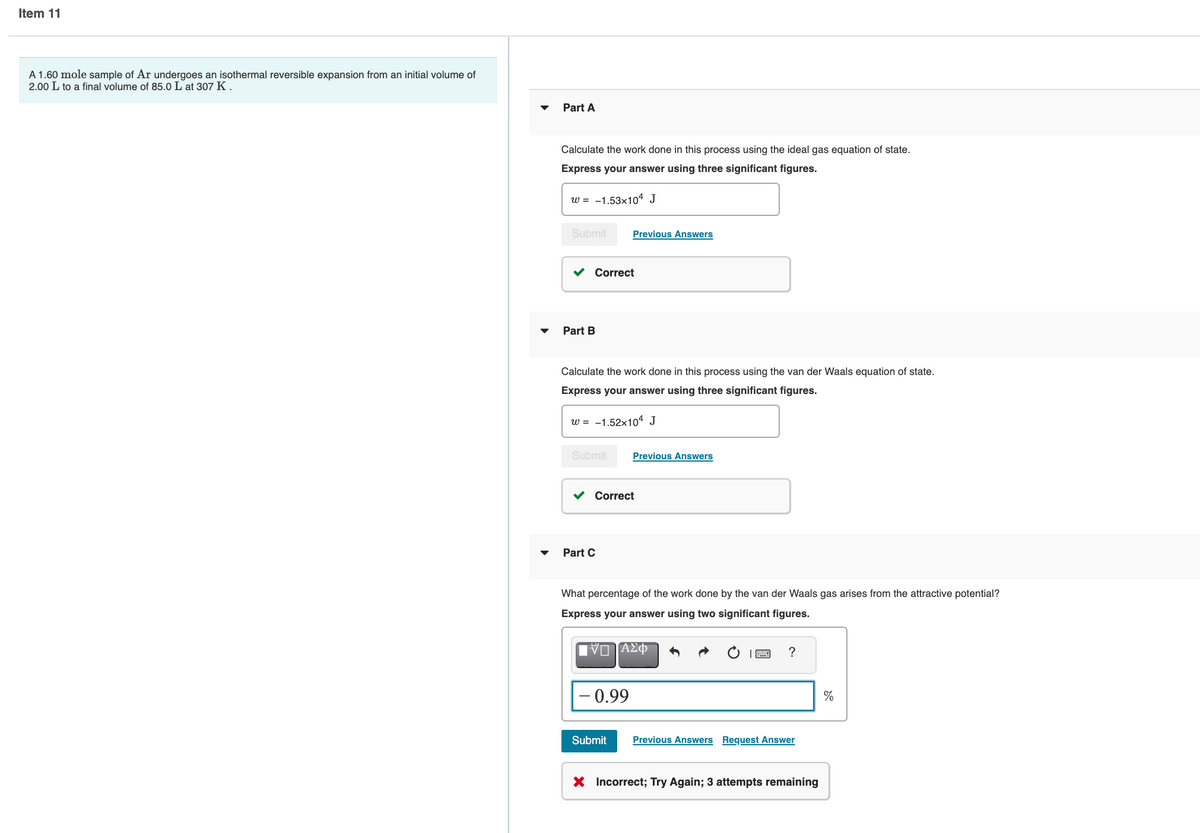Part C What percentage of the work done by the van der Waals gas arises from the attractive potential? Express your answer using two significant figures. VO A2 + ? · 0.99 % Submit Previous Answers Request Answer
Part C What percentage of the work done by the van der Waals gas arises from the attractive potential? Express your answer using two significant figures. VO A2 + ? · 0.99 % Submit Previous Answers Request Answer
Chemistry for Engineering Students
4th Edition
ISBN:9781337398909
Author:Lawrence S. Brown, Tom Holme
Publisher:Lawrence S. Brown, Tom Holme
Chapter9: Energy And Chemistry
Section: Chapter Questions
Problem 9.102PAE: 9.102 A runner generates 418 kJ of energy per kilometer from the cellular oxidation of food. The...
Related questions
Question

Transcribed Image Text:Item 11
A 1.60 mole sample of Ar undergoes an isothermal reversible expansion from an initial volume of
2.00 L to a final volume of 85.0 L at 307 K.
Part A
Calculate the work done in this process using the ideal gas equation of state.
Express your answer using three significant figures.
w = -1.53x104 J
Submit
Previous Answers
v Correct
Part B
Calculate the work done in this process using the van der Waals equation of state.
Express your answer using three significant figures.
w = -1.52x104 J
Submit
Previous Answers
Correct
Part C
What percentage of the work done by the van der Waals gas arises from the attractive potential?
Express your answer using two significant figures.
Vα ΑΣΦ
?
0.99
%
Submit
Previous Answers Request Answer
X Incorrect; Try Again; 3 attempts remaining
Expert Solution
This question has been solved!
Explore an expertly crafted, step-by-step solution for a thorough understanding of key concepts.
This is a popular solution!
Trending now
This is a popular solution!
Step by step
Solved in 2 steps with 2 images

Knowledge Booster
Learn more about
Need a deep-dive on the concept behind this application? Look no further. Learn more about this topic, chemistry and related others by exploring similar questions and additional content below.Recommended textbooks for you

Chemistry for Engineering Students
Chemistry
ISBN:
9781337398909
Author:
Lawrence S. Brown, Tom Holme
Publisher:
Cengage Learning

Principles of Modern Chemistry
Chemistry
ISBN:
9781305079113
Author:
David W. Oxtoby, H. Pat Gillis, Laurie J. Butler
Publisher:
Cengage Learning

Chemistry: Principles and Practice
Chemistry
ISBN:
9780534420123
Author:
Daniel L. Reger, Scott R. Goode, David W. Ball, Edward Mercer
Publisher:
Cengage Learning

Chemistry for Engineering Students
Chemistry
ISBN:
9781337398909
Author:
Lawrence S. Brown, Tom Holme
Publisher:
Cengage Learning

Principles of Modern Chemistry
Chemistry
ISBN:
9781305079113
Author:
David W. Oxtoby, H. Pat Gillis, Laurie J. Butler
Publisher:
Cengage Learning

Chemistry: Principles and Practice
Chemistry
ISBN:
9780534420123
Author:
Daniel L. Reger, Scott R. Goode, David W. Ball, Edward Mercer
Publisher:
Cengage Learning

Chemistry: The Molecular Science
Chemistry
ISBN:
9781285199047
Author:
John W. Moore, Conrad L. Stanitski
Publisher:
Cengage Learning

General Chemistry - Standalone book (MindTap Cour…
Chemistry
ISBN:
9781305580343
Author:
Steven D. Gammon, Ebbing, Darrell Ebbing, Steven D., Darrell; Gammon, Darrell Ebbing; Steven D. Gammon, Darrell D.; Gammon, Ebbing; Steven D. Gammon; Darrell
Publisher:
Cengage Learning

Chemistry
Chemistry
ISBN:
9781305957404
Author:
Steven S. Zumdahl, Susan A. Zumdahl, Donald J. DeCoste
Publisher:
Cengage Learning